Moldovan Essential Oils September 27, 2022
An Expanding Source of Supply?
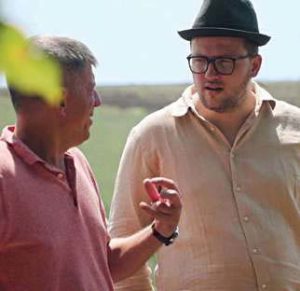 In July 2022 Gaetan Bourdeau, Ultra’s Chief Procurement Officer, made a short visit to Moldova to meet up with local partners to assess the current situation and discuss future developments. Currently Ultra sources a range of Moldovan essential and vegetable oils from local partners, including coriander seed, lavender, dill weed, sage, clary sage, hyssop, oregano, and sunflower oil. Ultra is constantly looking to expand and develop new sources of natural ingredient supplies. With the current severe restrictions on availability of essential oil and fixed oil supplies from Russia and Ukraine, the Ultra Group is looking to develop and expand supplies from Moldova with long term contracts. The following article reviews some of the challenges and opportunities facing the development of the Moldovan economy and its essential oil sector.
In July 2022 Gaetan Bourdeau, Ultra’s Chief Procurement Officer, made a short visit to Moldova to meet up with local partners to assess the current situation and discuss future developments. Currently Ultra sources a range of Moldovan essential and vegetable oils from local partners, including coriander seed, lavender, dill weed, sage, clary sage, hyssop, oregano, and sunflower oil. Ultra is constantly looking to expand and develop new sources of natural ingredient supplies. With the current severe restrictions on availability of essential oil and fixed oil supplies from Russia and Ukraine, the Ultra Group is looking to develop and expand supplies from Moldova with long term contracts. The following article reviews some of the challenges and opportunities facing the development of the Moldovan economy and its essential oil sector.
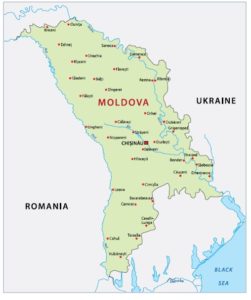 Until the Russian invasion of Ukraine in late February 2022, Moldova was an unknown country to most of the world. It borders Ukraine and Romania, and within the country is a breakaway Russian-controlled secessionist “Republic of Transnistria”, which has not been internationally recognised and through which runs a Russian gas pipeline to southern Europe. There is also Gagauzia, an autonomous region in southern Moldova, inhabited by Gagauz people, Turkic-speaking Orthodox Christians. Moldova is a small landlocked country of just under 33,000 sq km, some 350 km north to south and 150 km from west to east. In 2021 the population was estimated at 2.64 million with a GDP per head of US$ 4,514 the lowest in Europe (World Bank). Life expectancy at birth is just over 70 years.
Until the Russian invasion of Ukraine in late February 2022, Moldova was an unknown country to most of the world. It borders Ukraine and Romania, and within the country is a breakaway Russian-controlled secessionist “Republic of Transnistria”, which has not been internationally recognised and through which runs a Russian gas pipeline to southern Europe. There is also Gagauzia, an autonomous region in southern Moldova, inhabited by Gagauz people, Turkic-speaking Orthodox Christians. Moldova is a small landlocked country of just under 33,000 sq km, some 350 km north to south and 150 km from west to east. In 2021 the population was estimated at 2.64 million with a GDP per head of US$ 4,514 the lowest in Europe (World Bank). Life expectancy at birth is just over 70 years.
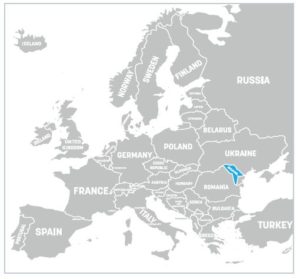 Moldova was part of the USSR (Union of Soviet Socialist Republics) but declared independence in 1991 following the USSR’s collapse. During the past 30 years the country has made considerable progress towards becoming a strong, independent, and market oriented democracy. In 2009 the country broke away from communist party leadership and a more western-orientated government was elected. A wide range of economic, social, and democratic reforms have been undertaken. In 2014 it signed a European Union (EU) Association agreement and in June 2022 the EU granted Moldova, along with Ukraine, candidate status which includes a list of additional reforms Moldova will need to implement as it seeks full EU membership. Application to join the EU is seen as a means of providing some degree of protection but the process can take a considerable amount of time. Certainly, the country has moved closer to Western Europe, taking advantage of its geographical and cultural connections. Moldova now benefits from liberalised trade and investment and is promoting the export of its goods and services, particularly those from the agricultural sector.
Moldova was part of the USSR (Union of Soviet Socialist Republics) but declared independence in 1991 following the USSR’s collapse. During the past 30 years the country has made considerable progress towards becoming a strong, independent, and market oriented democracy. In 2009 the country broke away from communist party leadership and a more western-orientated government was elected. A wide range of economic, social, and democratic reforms have been undertaken. In 2014 it signed a European Union (EU) Association agreement and in June 2022 the EU granted Moldova, along with Ukraine, candidate status which includes a list of additional reforms Moldova will need to implement as it seeks full EU membership. Application to join the EU is seen as a means of providing some degree of protection but the process can take a considerable amount of time. Certainly, the country has moved closer to Western Europe, taking advantage of its geographical and cultural connections. Moldova now benefits from liberalised trade and investment and is promoting the export of its goods and services, particularly those from the agricultural sector.
The Evolution of the Moldovan Essential Oils Sector
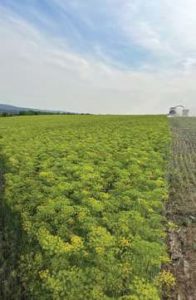 In the 1970s and 1980s, during the Soviet era, there was a considerable expansion of aromatic and medicinal plant production. Some 50,000 to 70,000 hectares (ha) were cultivated on 20 to 25 large specialised collective farms (kholkoze). There were about 15 different distillation sites, two of which undertook extraction. In the late 1980s Moldovia was annually producing some 160 to 200 MT of essential oils. These included: lavender 75-80 MT, clary sage 30–35 MT, dill 25-30 MT, mint 25–35 MT, fennel 16-20 MT and rose 5 MT. In addition, there were smaller quantities of other oils, such as hyssop and iris. Most production was shipped to Moscow which then distributed internally although some 20% to 30% was exported as “Russian essential oils”.
In the 1970s and 1980s, during the Soviet era, there was a considerable expansion of aromatic and medicinal plant production. Some 50,000 to 70,000 hectares (ha) were cultivated on 20 to 25 large specialised collective farms (kholkoze). There were about 15 different distillation sites, two of which undertook extraction. In the late 1980s Moldovia was annually producing some 160 to 200 MT of essential oils. These included: lavender 75-80 MT, clary sage 30–35 MT, dill 25-30 MT, mint 25–35 MT, fennel 16-20 MT and rose 5 MT. In addition, there were smaller quantities of other oils, such as hyssop and iris. Most production was shipped to Moscow which then distributed internally although some 20% to 30% was exported as “Russian essential oils”.
By the mid 2000s, some 15 years after independence, the area under cultivation had fallen dramatically to around 3,000 ha. Production was significantly lower compared with the figures from the late 1980s. One source estimated average annual production for 2005 – 2007 at: clary sage 2 MT of oil, 60 MT of extract, dill 6 MT, fennel 5 MT, coriander 5 MT, lavender 5 MT, sage officinalis 2 MT alongside smaller quantities of mint, hyssop, oregano, cumin, thyme and rose. However, harvests in 2007 were greatly reduced varying between 30% to 85% due to a major drought and high temperatures. For some plants, such as coriander and dill, the loss was almost 100%. Clary sage was the dominant aromatic plant but very little essential oil was produced due to Chinese competition. Most production was solvent extracted to produce clary sage concrete with +50% sclareol, most of which was used to prod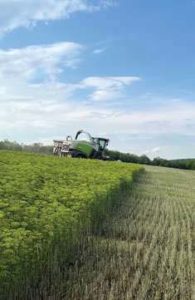 uce ambroxan, although small quantities were sold to perfumers. A decade ago, clary sage was reported to be in the hands of one company with annual production around 30 MT.
uce ambroxan, although small quantities were sold to perfumers. A decade ago, clary sage was reported to be in the hands of one company with annual production around 30 MT.
Exact data on current production and exports are not available but a large range of essential oils are still being produced, including clary sage, seed oil, dill, fennel, oregano, sage oil as well as hyssop, wormwood, savory and thyme. Hundreds of farmers are reported to be growing lavender, while coriander seed oil is being produced to replace Russian coriander seed oil, which many companies have ceased purchasing. Russian production of coriander herb/leaf (cilantro) oil is small. Most of the cilantro oil comes from Moldova, although in the past it has been sold as Russian origin. Both the production levels and area of land under cultivation are greater than those estimated during the period 2005 – 2007 – and there is increasing interest and optimism in developing essential oil production in Moldova.
Challenges
Despite the considerable progress made over the past three decades the country faces many challenges:
- It is the poorest country in Europe, with a very narrow economic base and GDP per head about a seventh of the regional average of US$ 33,000. It has been heavily dependent on remittances from Moldovans working abroad. Following independence there was a massive exodus of workers primarily to Western Europe and Russia, with approximately 25% of the population working abroad, representing one of the world’s largest net emigration countries. Economic recovery was primarily driven by workers’ remittances.
- Moldova has been beset by multiple shocks in the past two years. The COVID-19 pandemic was followed by a severe drought that reduced agricultural production by 34% in 2020, while the European gas crisis pushed gas prices up by around 400% in the second half of 2021 – since when they have risen further.
- In February 2022 began the devastating war between Russia and Ukraine, which has further exposed the country’s vulnerability and put at risk its short-term economic recovery and its long-term economic prospects. The past few months have been a traumatic experience. Moldova is likely to be the external country most affected by the war. This is not only because of its physical proximity to Russia and Ukraine but also because of its landlocked economy with very close linkages to both countries. There have been severe disruptions in the supply chains for food, energy, and raw materials leading to significant upward price pressures. The longer the war continues the greater the challenge to Moldova’s socio-economic environment.
- Following the outbreak of war there has been a massive influx of refugees accounting for approximately 15% of the population, the largest percentage for any country.
- Weak institutional and governance structure, especially in the financial sector and IP enforcement. The legal and regulatory framework is poor.
- Pervasive corruption and bureaucracy have historically stifled entrepreneurship but the government is pressing ahead with anti-corruption initiatives.
- The government is introducing laws and regulations to harmonise with EU legislation but full compliance with EU legislation and standards will take a considerable amount of time. Businesses still face burdensome licensing procedures and excessive authorisation requirements.
- Outward migration has led to an ageing population and a dwindling labour force. Moreover, the internal market is relatively small.
- The economy is dependent on imports of energy from Russia and the economy has been very inefficient in its energy usage.
- Climatic factors such as drought and flooding are constant risks to the agricultural sector. In recent years weather events in Moldova have increased in severity, longevity, and frequency; in particular, droughts and floods have impacted agricultural production. More variability in rainfall arising from climate change has increased the risk of floods in addition to drought. In 2022 the drought has certainly led to lower yields.
- During the 21st century Moldova has had sustained economic growth but it remains one of the poorest countries in Europe. Growth was very dependent on remittances from a migrant workforce. The fall in remittances combined with a falling and ageing population has led to declining growth rates and low productivity growth. A significant number of the lower-income population have become dependent on pensions and social assistance.
Opportunities
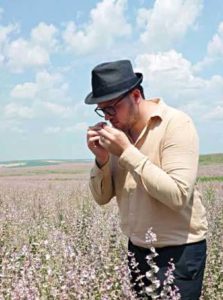 Agriculture is the main pillar of the economy. It employs almost 30% of the country’s labour force, accounts for about 12% of GDP, 16% if food processing is included, and nearly half of total export value. Farmland covers approximately 2.5 million hectares or 75% of the country’s land area – and some 1.8 million ha is arable land predominantly privately owned.
Agriculture is the main pillar of the economy. It employs almost 30% of the country’s labour force, accounts for about 12% of GDP, 16% if food processing is included, and nearly half of total export value. Farmland covers approximately 2.5 million hectares or 75% of the country’s land area – and some 1.8 million ha is arable land predominantly privately owned.- From the late 1990s the collective farming sector has been reformed and by the early 2000s the reform was completed, resulting in a highly equitable distribution of agricultural land and a new class of landed independent farmers. The new corporate farms were about a third of the size of former collectives (i.e., 650 ha) but often run similarly to the former collectives.
- The history of the aromatic plant production goes back many years with most of the growth undertaken when Moldova was part of the USSR. During this period annual production reached an annual 200 MT produced from about fifteen factories. The main season for harvesting aromatic crops in Moldova is from June to August.
- High-value agriculture such as aromatic plants remains underdeveloped in Moldova but offers good opportunities for investors, although foreigners are not permitted to directly own land.
- The country has favourable conditions for agricultural production including favourable soil resources. Some 75% of the land is fertile black soil (called “chernozem” – one of the most fertile in the world) ideal for growing a wide range of fruit, vegetables, and aromatic plants.
- The moderate continental climate is also favourable with short relatively warm winters and hot summers enabling early planting and providing producers with a competitive advantage.
- There is considerable agricultural knowledge and experience. This combined with relatively low labour costs, especially in rural areas, and high yields facilitates the production of labour-intensive crops that are competitive on world markets.
- There is increasing demand for organic products, creating opportunities for organic farming, which has been growing in Moldova, in part because of support for the sector and higher price premiums.
- Most Moldovan companies are privately owned but some cooperatives are operating. For example, in 2020 the Moldova Lavender Producers Association helped establish the Essential Oils Cooperative of Moldova (COOM), which is made up of a group of aromatic and medicinal plant producers.
- It is now much easier to ship essential oils from Moldova to western Europe than from Ukraine or Russia and hence the growing interest in expanding production.
- Neighbouring Romania is a member of the EU and Moldova is culturally more Romanian than Russian. Just over 80% of the population speak Moldovan/Romanian as their mother tongue – Moldovan is virtually the same as Romanian. 10% speak Russian. The younger generations in Moldova are much more drawn to the west.
In the Soviet era Moldova was a sizeable producer of aromatic plants and related essential oils. If, over the next few years, the Moldovan political and economic environment stabilises, then this small strategically placed country has the land, labour skills and knowledge and access to investment sources to expand production to satisfy the increasing global demand for natural, traceable, sustainable, and high-quality essential oils.
 Ultra International B.V.
Ultra International B.V.